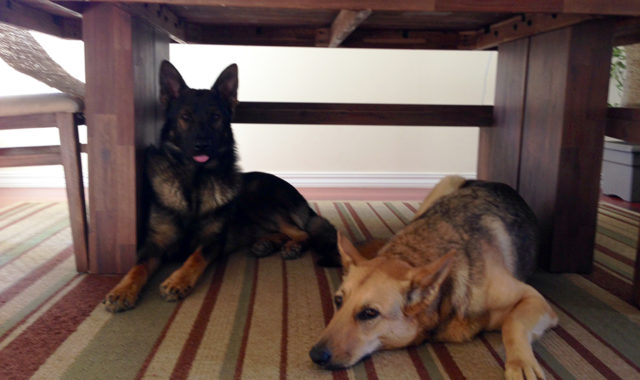Crates often get a bad rap, particularly in new dog owners. As humans, we view them in this prison-like manner. But remember, your dog is, well…a DOG. He doesn’t know about San Quentin, Alcatraz, the hole or striped uniforms. What he does know is that his little lizard brain tells him that he should seek out a safe and secure shelter for sleep and rest. Has your dog ever rested under the dining table or in a dark closet? Now you know why…he’s following his instincts.
Crates are useful for a variety of reasons, but the number one, in my book, is to housetrain a puppy or dog. Dogs have an innate instinct to keep their den clean, which means you can take full advantage of that fact and help him learn that he needs to eliminate outside.
As with all things, you want to ensure that you introduce the crate gradually and with positive associations. The crate needs to be the party place. Remember when you were younger…there was always that one house party that everybody HAD to be at? That should be how your dog views his crate. Giving your dog a special toy or treat that he ONLY gets when he’s in his crate is a really great idea (Kongs are great for this). NEVER force a dog or puppy into a crate. NEVER shut them in on the first experience. NEVER leave them alone on the first experience. NEVER use the crate as a punishment. Remember…fun, positive and rewarding experiences. You want your dog or puppy to LOVE their crate. As your dog becomes more and more comfortable with his crate, you can gradually increase the amount of time spent in the crate. But please do not abuse or overuse the crate.
Look for a crate that is large enough to allow your dog the room to stand up and turn around and stretch, but not too large. You don’t want your puppy to use one side to rest and the other to eliminate in. If you do want to purchase a larger crate so that you don’t have to purchase another as the dog gets older, there are models that also include a divider so that the crate can be expanded as the dog grows.
When you release your dog from its crate…immediately take him outside to eliminate. Don’t just let the dog or puppy outside in the backyard, make sure he is supervised. The reason for this is two-fold:
- When he does…praise! Help him to understand that this is the best thing EVER.
- You can take him to one spot in the yard so that becomes the potty spot.
Another important thing to remember is to not release your dog from his crate if he is whining. Your dog will quickly learn that whining equals being released from his crate and, guess what, he just trained you! Only release your dog when he is in a calm state of mind and don’t make a big production about him coming out of the crate.
For puppies or dogs that are not housebroken, you will need to continually supervise them once inside the house (there should be boundaries determined in the home). By keeping them on a consistent feeding and crate training schedule, you should quickly have a housebroken dog.
So, what do you do if you did force your dog into the crate? Or if you didn’t use a crate to start with and now your dog eliminates in the house? Or if you have an older dog who was never crate trained? I’m not going to lie, depending on the dog, you might have a bit of work ahead of you. You will need to be consistent in your schedule and, in the case of any negative associations with crates, do some counter-conditioning to get the dog over any fears that it might have with the crate. It takes hard work and patience and time.
If you have any questions about crate training your puppy or dog, we are here to help. Please give us a call.

